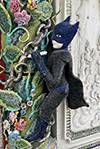|
Wat Pariwaht Ratchasongkraam (วัดปริวาสราชสงคราม)
Thai. Name of a
riverside Buddhist temple
with an enclosing wall
along the
Chao Phraya in
Bangkok,
which features flamboyant
mosaics and sculptures from various religions and cultures,
international history and mythology, and even international idols
from famous cartoons and pop-culture icons, as well as creatures of
fantasy and imagination, all incorporated into typical Thai-style
beautification. Among the sculptures are
gods, angels, hermits, giants,
devils, various —often compound— animals, and important characters,
such as from the
Ramakien and
Three Kingdoms, but also
sculptures of
dragons,
cowboys, Vikings, King Arthur, Pharaohs,
samurai, Indians, Pinocchio,
Batman, and so on. The
ubosot, of which
the inner walls are decorated with
benjarong,
is known as the
Benjarong
Stucco
Sculpture
Bot, and
houses the more than 700 year old
Sukhothai
Buddha Statue.
Coloured stones and gems are used to
make the murals that never repeat the same pattern. The
chofa on top of the ubosot's
roof is made to represent a blooming lotus and is made of more than
a kilogram of gold.
Whilst its completion took five years, work on the
wihaan, the inner court and surrounding
gallery, as well as
on the twin
stupas
flanking the main entrance to the south was still in progress in
early 2023 and the total
construction budget is expected to be over 250 million baht.
Whilst the entrance
door to the ubosot is flanked with the 12 animals from the Chinese
zodiac, six on either side, the entrance door to the wihaan is
decorated with the 12 signs from the horoscope, also six on either
side. In the corners of the inner courtyard are carved marble
statues, each depicting an important stage in the life of the
Buddha, namely —starting
in the southwestern corner in clockwise order with— his birth or
Phrasoot;
then his
Enlightenment seated underneath the
bodhi tree, although here
depicted seated in the
mortification pose, the attitude of suffering which in Thai is known
as
pahng thukkarakiriyah
and thus combining these two episodes in his life;
then
the
Buddha's
very first public discourse on his doctrine given to his five
disciples called
panjawakkie;
and finally
his demise known as the
Mahaparinippahn,
Mahaparinirvana,
parinippahn or
parinirvana. The temple, formerly
called Wat Pariwaht (วัดปริวาส),
is assumed to be built around the end of the
Ayutthaya
Period and the early
Rattanakosin Period and in
the reign of King
Rama II and
Rama III was in a dilapidated
condition.
There
is evidence that then
Phraya
Phetpichai (เพชรพิชัย)
and Phraya Ratchasongkraam (ราชสงคราม)
renovated the temple and renamed it Wat Pariwaht
Ratchasongkraam.
Because this temple is located next to the water, the original
ubosot was by the year 2008 AD falling to pieces due to the
soil collapsing. The abbot therefore built a new ubosot with a
wihaan and the area inside is no longer adjacent to the waterfront.
WATCH VIDEO (1)
and
(2).
回






|

